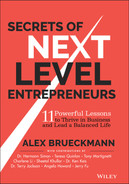Introduction
Why I Compiled This Book and Who It Is For
We have gotten used to reading that we live in unprecedented times, that the speed of change and disruption has never been greater than now, and that our world is increasingly volatile, uncertain, complex, and ambiguous. As if we had required any more proof that these statements are true, the COVID‐19 pandemic and the war in Ukraine remind us that peace, prosperity, and health cannot be taken for granted. Effectively, we are witnessing supply chain disruptions and inflation rates higher than we've seen in recent decades, especially in the Western hemisphere.
We have been adjusting our consumption patterns, with consequences for how much money we spend. We see new demands from an increasingly flexible workforce, challenging traditional career paths and prioritizing their personal over work lives. Digital innovation has maintained a high pace. While it enables new business models and entire industries on the positive end, it can also feel overwhelming to keep up to speed with digital transformation.
Countless businesses, small and large, were swept away by the chain of events that sparked in 2020. Some of them had operated unsustainably for a while; for them, these crises were the nail in the coffin. Others operated under business models that were profitable but too inflexible. They got dragged under the bus because they couldn't adjust to a rapidly changing environment. All other businesses must learn the lessons and equip themselves for the next inevitable inflection point. And come it will.
If we learned one takeaway over the past two decades, it is hopefully this: the next crisis is already waiting around the corner. I have spent almost my entire adult life in one crisis or another, from the dot‐com bubble burst, the war on terrorism, the financial crisis, the state debt crisis, the refugee crisis, the COVID‐19 pandemic, and Russia's war in Ukraine, to name the most prominent ones.
Let's be honest: crisis mode seems to be the new normal. And most of these crises are outside our immediate circle of control. But it's not all doom and gloom. The changing landscape opens opportunities for business owners willing to create more appealing offerings for consumers, employees, and shareholders. Instead of hoping and waiting for better times, we must adjust our businesses strategically and operationally to make the most out of what we can immediately influence.
As entrepreneurs, corporate leaders, and business owners, we must prepare ourselves and those who work with us for the future. It starts with us and how we grow beyond what we know today. What made us successful in the first place—the subject matter expertise we used to build our businesses—will not suffice to create the same caliber of success. We must learn essential skills, understand ourselves, and shift our mindsets accordingly. The time is now to reach the next level and grow beyond existing limits—personally and professionally.
There are three mission‐critical pillars that contribute to building future‐proof businesses: strategy, leadership, and self‐care. It's essential to strategically re‐adjust a business for success, consciously shape leadership and culture, and practice self‐care as we humbly accept our limitations as entrepreneurs and leaders.
Instead of celebrating the hustle culture, promoting a glamorous view of entrepreneurship, or glorifying the few that amassed incredible wealth, this book is about, what I call, Next‐Level Entrepreneurship. It's about building businesses that take the right steps to do well, be profitable, and contribute to building more equitable communities. It is for entrepreneurs and leaders who embrace their responsibility for social and environmental justice, and are eager to contribute to a world worth living in—for us, our children, and generations to come.
This book holds specific advice on issues that are on the mind of every business owner and leader at one point or another. I invited some of the brightest minds to contribute their perspectives on Next‐Level Entrepreneurship. We shed light on a range of interconnected topics that are critical success factors in today's business world. This is not a theoretical textbook. Instead, we offer actionable solutions that you can put into practice right away—written by business owners and leaders for business owners and leaders.
Based on his ten commandments, Hermann Simon helps us sharpen our understanding of pricing in a high inflation environment. With the zeitgeist shifting our perception of businesses, Sheetal Khullar introduces a model for a socially and environmentally sustainable business approach. Tony Martignetti and Terry Jackson offer insights into leadership components that allow us to build people‐centric, high‐performance cultures in the workplace. Teresa Quinlan and Ken Keis show ways to overcome the outdated paradigm of work‐life balance and instead self‐actualize and achieve personal transformation.
Depending on your personal experience, some chapters will be easier to engage with—previously overlooked perspectives are waiting for you as you read some chapters with a beginner's mind. Other chapters hold suggestions that might feel unfamiliar or foreign at first sight. Allow yourself to approach them with the open mind of an eager learner to explore what's in it for you.
I encourage you to embrace the full variety of topics we cover, as all of them are critical factors to living a happier, healthier, and more fulfilling life—including leading a limitless business.
You'll find that each chapter comes with an ‘About the Author’ section. Many of the authors have published books on their subjects that will help you dive deep into your topics of interest. The authors invite you to connect on social media and to benefit from additional resources on their websites.
With that, I hope you enjoy the book and stay courageous.
